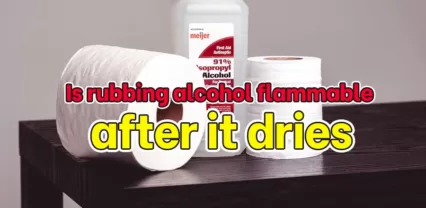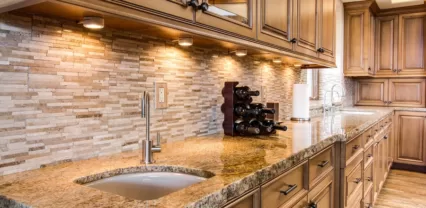While browsing the cleaning aisle at your local supermarket, you’re likely to notice that the ingredients on cleaning products are a lot, featuring chemicals you can’t even spell right. Cleaning solutions with fewer chemicals is becoming increasingly popular, as individuals want to improve their health and lifestyle.
As an example, some individuals use rubbing alcohol. We keep rubbing alcohol in our medical cabinet since it can assist in removing sticky muck and also works as a disinfectant plus it’s inexpensive. However, will rub damaged furniture? That’s something you’ll discover in this article.

Does rubbing alcohol stain furniture
Yes!! Rubbing alcohol does leave a stain on furniture however, it’s mostly wooden-made one that is affected the most.
Rubbing alcohol on wood not only causes stains but also does far more than that. For example, some furniture finishes can be damaged by the use of rubbing alcohol (also called isopropyl alcohol) on the surface. A few drops of rubbing alcohol may do more than just discolor wood, even in little amounts.
Wood furniture coatings are destroyed when exposed to alcohol, which acts as a solvent. The harm from such type of accident however can be minimized. The process of minimizing the damage caused by rubbing alcohol should be performed immediately otherwise the alcohol will dissolve within the upper coat of the furniture, causing discoloration and finish damage.
To minimize the damage, you need to sob the rubbed alcohol immediately. The sooner you do it, the lesser its quantity will dissolve within the furniture.
Can you clean wood furniture with rubbing alcohol
The answer would be a big NO! And here is the reason why.
The fact that why we keep rubbing alcohol on almost every stain we see is because alcohol can dissolve sticky muck and disinfect. Cost-effectiveness and versatility make it a very desirable tool to use.
However, you should never, ever use it on wood furniture. If you want to, make sure to use it on bare wood before it does through the finishing process. Alcohol damages wooden finishing, making the furniture appear discolored and old.
Don’t just put alcohol directly on the wooden furniture, simply prepare a solution by mixing the rubbing alcohol with water. Water decreases its ability to get dissolved within the furniture, causing it to do its cleaning job without causing any damage.
What does rubbing alcohol do to wooden furniture
Alcohol is a great source of cleaning any nasty stains on a surface. It’s also a disinfectant so most people use it in their daily lives for various things since not only is it effective, but also cheap. However, it’s a bad choice for wooden furniture.
Well as mentioned previously, some furniture finishes can be damaged by the use of rubbing or isopropyl alcohol. A few drops of rubbing alcohol for example may do more than just discolor wood, even in little amounts (drops, in spray form, or even a touch of alcohol on a surface).
Wood furniture coatings are destroyed when exposed to alcohol, which acts as a dissolving solution on them. If you have a wooden table, then keep in mind that the look of a tabletop is ruined by alcohol stains. This substance can dissolve shellac and varnish, causing irreversible damage to wood.
Wood surfaces get increasingly damaged as time goes on. And if you don’t do anything as soon as the wooden surface touches alcohol, then you just got yourself in big trouble for a long time.
What is the difference between rubbing alcohol and denatured alcohol
Rubbing alcohol is a general name for isopropyl alcohol, which is what’s used to clean several types of stains. As a topical treatment, rubbing alcohol is classified as a surgical spirit rather than a methylated spirit. For home or commercial use, the product can be used as a mild solvent replacement.
Denatured alcohol on the other hand is used as a reliable cleaning tool to remove stains, spots, and dirt. The qualities of denatured alcohol are particularly useful when the material shouldn’t be left on the surface for too long.
The denaturants available in different brands of denatured alcohol include bittering compounds. Additives with a poor taste, unpleasant smell, or sickening properties are used within denaturants, causing them to prevent people from drinking.
To sum it up, rubbing alcohol is used as a mild cleaning solvent and as an antibacterial. While uses for denatured alcohol include using it as an antibacterial, a fuel additive, and even sanding and polishing. It’s necessary to take extra measures while handling either form in a confined setting or when using big quantities of any of them.
Is denatured alcohol safe on furniture
Yes! Denatured alcohol is quite a safer option than rubbing alcohol when it comes to cleaning stains from furniture. As compared to rubbing alcohol, denatured alcohol is quite safe to use on any type of furniture even wood.
The denatured alcohol works effectively in removing germs and bacteria, oil stains, and even grease spots for wood furniture. Moreover, you can even use the material for removing latex, shellac, lacquer, and polyurethane type of finish from furniture since it’s not too toxic.
However, bear in mind the product is hazardous and highly flammable, so do not use it near fire or it will cause you serious issues.
How to remove rubbing alcohol stains from wood furniture
The white stains you see developed on wood furniture after it has been exposed to alcohol are a result of sealant degradation. This is something that needs your immediate attention however in certain cases, refinishing the wood may not be necessary. To remove these stains, follow these simple 7 steps:
- Blot any current liquid with paper towels or absorbent cloths to prevent the spread of alcohol on the wooden surface. If you rub, you will simply push it further into the finish or the grain of the wooden surface so don’t do that.
- You can clean the afflicted area by wiping it with a solution of dish soap in a per gallon warm water bucket. This gentle cleaning solution eliminates sugars and other flavoring components in alcoholic drinks, resulting in removing certain color stains that haven’t sunk too deeply.
- Any alcohol residue in the finish can be removed by rubbing the affected area with wax or linseed oil. For old stains, combine wax or linseed oil with rottenstone and rub it to the grain of the wood.
- Sift the damaged area with sandpaper to remove any remaining finish that has been penetrated by the alcohol mixture. There is a chance that chlorine bleach will be able to get rid of the discoloration.
- Overnight, cover the discolored area with a thick layer of household bleach and let it soak in. Re-apply the treatment if you see a difference in the morning. If you don’t see a difference after bleaching, your only option is to sand and scrape.
- To remove the top layers of wood, use a pull scraper and continue sanding using sand by sand along with a sandpaper.
- Refinish the surface as a first layer using a brush or a spray can. Using 220-grit paper and 220-grit varnish sandpaper, apply the second layer.
And there you have it, you’re wooden surface is as good as new again.
Conclusion:
Rubbing alcohol is a great yet gentle cleaner however, it’s not recommended to be used on wooden furniture. Going for denatured alcohol is a more suitable option especially for wooden furniture. Both have good solvents, but it depends on the user to use the products based on his/her liking.



